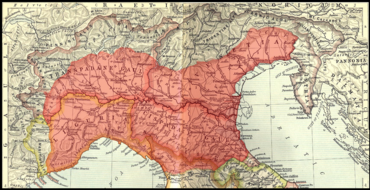
Back Gallia Cisalpina Afrikaans Gallia cisalpina ALS غاليا كيسالبينا Arabic Цызальпійская Галія Byelorussian Цизалпийска Галия Bulgarian Gallia Cisalpina Breton Gàl·lia Cisalpina Catalan Předalpská Galie Czech Gallia Cisalpina Welsh Gallia Cisalpina Danish

Cisalpine Gaul (Latin: Gallia Cisalpina, also called Gallia Citerior or Gallia Togata[2]) was the name given, especially during the 4th and 3rd centuries BC, to a region of land inhabited by Celts (Gauls), corresponding to what is now most of northern Italy.
After its conquest by the Roman Republic in the 200s BC, it was considered geographically part of Roman Italy but remained administratively separated until 42 BC.[3] It was a Roman province from c. 81 BC until 42 BC, when it was de jure merged into Roman Italy as already planned by Julius Caesar.[4][5]
Cisalpine means "on this side of the Alps" (from the perspective of the Romans), as opposed to Transalpine Gaul ("on the far side of the Alps").[6]
Gallia Cisalpina was further subdivided into Gallia Cispadana and Gallia Transpadana, i.e., its portions south and north of the Po River, respectively.
The Roman province of the 1st century BC was bounded on the north and west by the Alps, in the south as far as Placentia by the river Po, and then by the Apennines and the river Rubicon, and in the east by the Adriatic Sea.[7]
In 49 BC, all inhabitants of Cisalpine Gaul received Roman citizenship,[8] and eventually the province was divided among four of the eleven regions of Italy: Regio VIII Gallia Cispadana, Regio IX Liguria, Regio X Venetia et Histria, and Regio XI Gallia Transpadana.[9]
- ^ The Historical Atlas by William R. Shepherd, 1911 edition
- ^ von Hefner, Joseph (1837). Geographie des Transalpinischen Galliens. Munich.
- ^ Umberto Moscatelli (2010). "University of Macerata. I Romani in montagna: tra immaginario e razionalità".
- ^ Williams, J. H. C. (2001). Beyond the Rubicon: Romans and Gauls in Republican Italy. Oxford University Press. ISBN 978-0-19-815300-9. Archived from the original on 2020-05-22.
- ^ Long, George (1866). Decline of the Roman republic: Volume 2. London.
{{cite book}}: CS1 maint: location missing publisher (link) - ^ Snith, William George (1854). Dictionary of Greek and Roman geography: Vol.1. Boston.
{{cite book}}: CS1 maint: location missing publisher (link) - ^ Schmitz, Leonhard (1857). A manual of ancient geography. Philadelphia: Blanchard and Lea.
- ^ Cassius Dio XLI, 36.
- ^ Brouwer, Hendrik H. J. (1989). Hiera Kala: Images of animal sacrifice in archaic and classical Greece. Utrecht.
{{cite book}}: CS1 maint: location missing publisher (link)